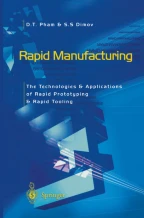Applications of Rapid Prototyping Technology

Rapid Prototyping (RP) is a continuously evolving technology. RP models are becoming widely used in many industrial sectors. Initially conceived for design approval and part verification, RP now meets the need for a wide range of applications from building test prototypes with material properties close to those of production parts to fabricating models for art and medical applications. In order to satisfy the specific requirements of a growing number of new applications, special software tools, build techniques and materials have been developed. This chapter discusses the use of RP in five different application areas: building functional prototypes, patterns for castings, medical models, artworks and models for engineering analysis. In addition, the chapter outlines the technological capabilities of RP processes in the context of each particular application and discusses specific issues relating to the efficient integration of these techniques into existing manufacturing routes.
This is a preview of subscription content, log in via an institution to check access.
Access this chapter
Subscribe and save
Springer+ Basic
€32.70 /Month
- Get 10 units per month
- Download Article/Chapter or eBook
- 1 Unit = 1 Article or 1 Chapter
- Cancel anytime
Buy Now
Price includes VAT (France)
eBook EUR 106.99 Price includes VAT (France)
Softcover Book EUR 137.14 Price includes VAT (France)
Tax calculation will be finalised at checkout
Purchases are for personal use only
Preview
References
- 3D Systems Newsletter (1994) The Edge, Summer, 3D Systems, 26081 Avenue Hall, Valencia, California, USA. Google Scholar
- Anatomies Case Studies (2000) Anatomies Rty. Ltd Queensland, Australia, http://glacier.qmi.asn.au:80/anatomics/.
- Beaman JJ, Barlow JW, Bourell DL, Crawford RH, Marcus HL and McAlea KP (1997) Solid Freeform Fabrication: A New Direction in Manufacturing, Kluwer Academic Publishers, Dordrecht, The Netherlands. BookGoogle Scholar
- CALM Project Final Report (1998) University of Central Lancashire, Preston, http://www.uclan.ac.uk/clt/calm/overview.htm.
- DTM White paper (2000) Functional prototyping with DuraForm and SLS, DTM Corporation, Austin, Texas, USA, 2000. Google Scholar
- D’Urso PS, Atkinson RL, Lanigan MW, Earwaker WJ, Bruce IJ, Holmes A, Barker TM, Effeney DJ and Thompson RG (1998) Stereolithographic biomodelling in craniofacial surgery, The British Journal of Plastic Surgery, Vol. 51, 7, pp 522–530. ArticleGoogle Scholar
- D’Urso PS, Atkinson RL, Weidmann MJ, Redmond MJ, Hall BI, Earwaker WJ, Thompson RG and Effeney DJ (1999a) Biomodelling of skull base tumours. The Journal of Clinical Neuroscience, Vol. 6, 1, pp 31–35. ArticleGoogle Scholar
- D’Urso PS, Barker TM, Earwaker WJ, Bruce IJ, Atkinson RL, Lanigan MW, Arvier JF and Effeney DJ (1999b) Stereolithographic biomodelling in cranio-maxillofacial surgery: a prospective trial. The Journal of Cranio-maxillofacial Surgery, Vol. 27, pp 30–37. ArticleGoogle Scholar
- D’Urso PS and Redmond MJ (2000), Method for the Resection of Cranal Tumours and Skill Reconstruction. British Journal of Neurosurgery. Vol. 4, 6, pp 555–559, http://www.tandf.co.uksee also [Anatomies, 2000]. Google Scholar
- Gatrzen J, Lingens H, Gebhardt A and Schwarz C (1998) Optimisation using THESA, Prototyping Technology International ’98 UK & International Press, Surrey, UK, pp 36–38. Google Scholar
- Ippolito R, Iuliano L and Gatto A (1995) Benchmarking of Rapid Prototyping Techniques in Terms of Dimensional Accuracy and Surface Finish, CIRP Annals, Vol. 44, l, pp 157–160. ArticleGoogle Scholar
- Jacobs PF (1996) Stereolithography and other RP&M technologies, Society of Manufacturing Engineers - American Society of Mechanical Engineer. Google Scholar
- Materialise Product Information (2000) Mimics software, Materialise, Leuven, Belgium, http://www.materialise.be/. Google Scholar
- McAlea K, Lackminarayan U and Maruk P (1996) Selective Laser Sintering of Metal Molds: The Rapid Tool™ Process, Moldin’96, ECM Inc., Plymouth, M.I Google Scholar
- Lightman AJ, Vanassche B, D’Urso P and Yamada S (1995) Applications of Rapid Prototyping to Surgical Planning - A Survey of Global Activities. Proc of the 6th International Conference on Rapid Prototyping, June 4–7, Dayton, Ohio, USA, pp 16–21. Google Scholar
- Pham DT, Dimov SS and Lacan F (1999) Selective Laser Sintering: Applications and Technological Capabilities, Proc. IMechE, Part B: Journal of Engineering Manufacture, Vol. 213, pp 435–449. ArticleGoogle Scholar
- Poulsen M, Lindsay C, Sullivan T and D’Urso PS (1999) Stereolithographic modelling as an aid to orbital brachytherapy. The International Journal of Radiation Oncology, Biology and Physics, Vol. 44, 3, pp 731–735. ArticleGoogle Scholar
- Raymond NC and Thomas VJ (1998) A Comparison of Rapid Prototyping Techniques Used for Wind Tunnel Model Fabrication, Rapid Prototyping Journal, MCB University Press, Vol. 4, 4, pp 185–196. ArticleGoogle Scholar
- Van de Crommert S, Seitz S, Esser KK and McAlea K (1997) Sand, Die and Investment Cast Parts via the SLS Selective Laser Sintering process, DTM GmbH, Hilden, Germany. Google Scholar
Author information
Authors and Affiliations
- Manufacturing Engineering Centre, School of Engingeering, Cardiff University, CF24 0YF, Cardiff, UK D. T. Pham BE, PhD, DEng, FREng, CEng, FIEE & S. S. Dimov Dipl Eng, PhD
- D. T. Pham BE, PhD, DEng, FREng, CEng, FIEE
You can also search for this author in PubMed Google Scholar
You can also search for this author in PubMed Google Scholar
Rights and permissions
Copyright information
© 2001 Springer-Verlag London Limited
About this chapter
Cite this chapter
Pham, D.T., Dimov, S.S. (2001). Applications of Rapid Prototyping Technology. In: Rapid Manufacturing. Springer, London. https://doi.org/10.1007/978-1-4471-0703-3_5
Download citation
- DOI : https://doi.org/10.1007/978-1-4471-0703-3_5
- Publisher Name : Springer, London
- Print ISBN : 978-1-4471-1182-5
- Online ISBN : 978-1-4471-0703-3
- eBook Packages : Springer Book Archive
Anyone you share the following link with will be able to read this content:
Get shareable link
Sorry, a shareable link is not currently available for this article.
Copy to clipboard
Provided by the Springer Nature SharedIt content-sharing initiative

